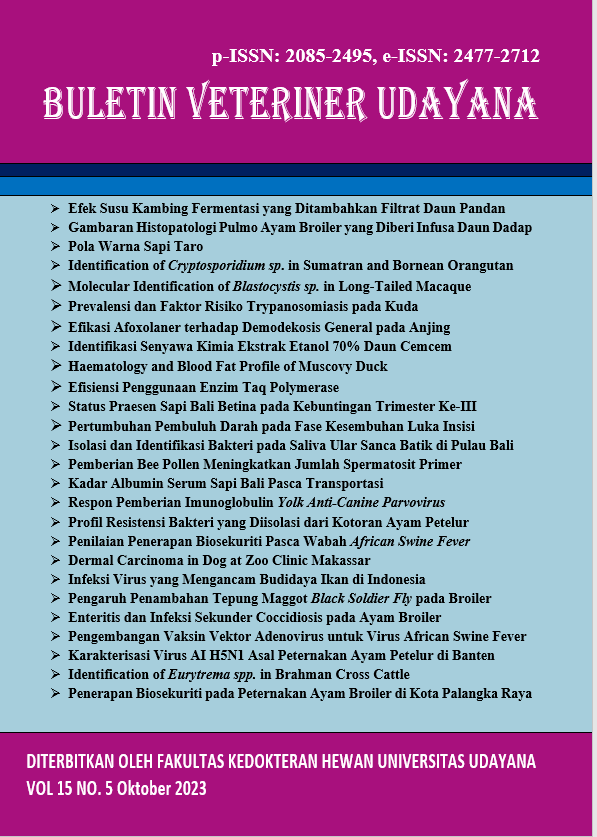EFFICIENCY OF USING TAQ POLYMERASE ENZYME IN POLYMERASE CHAIN REACTION TESTING
Abstract
Polymerase Chain Reaction (PCR) is a very sensitive diagnostic test. The Taq Polymerase enzyme is one of the most important components in the Polymerase Chain Reaction (PCR) assay. The taq polymerase enzyme is the most expensive component. The use of taq polymerase in the PCR test is less efficient. To determine the efficiency of using the Taq Polymerase enzyme and at what smallest volume it can still be used in the PCR test method, a study was conducted by making the PCR volume smaller (5µl, 10µl, and 25µl) than the standard (50 µl). Three isolates of nasal and anal swabs of dogs infected with Parvovirus were extracted using the DNA Purification Kit. The extraction results are used as DNA templates for PCR testing. Amplification using the PCR Apply Biosystem Thermal Cycler machine. Visualization of amplification products using 1% agarose gel electrophoresis. The test results show that the PCR volume is smaller than the standard and is able to visualize the PCR product well. In 5µl volume PCR, not all samples were amplified well. Samples 1 and 3 show a thick band at the same position as the positive control. While sample 2 does not show any bands. At the PCR volume (10µl, 25 l and 50µl) all samples were amplified well. Samples 1 and 3 show a thick band at the same position as the positive control. Amplification of samples 1 and 3, the gene has a nucleotide length of 910bp (according to oligonucleotides), while sample 2 also shows the presence of a band but its position is lower and thinner than samples 1, 3 and positive control. The difference in the thickness of the amplified band was caused by differences in the concentration of the extracted DNA. The difference in amplified band height in sample 2 means that the amplified gene is not a parvo-specific gene. The conclusion of this study is that the volume of PCR testing with a volume that is smaller than the standard is able to visualize the parvo virus DNA gene well. To efficiently use the taq polymerase enzyme in PCR testing, a PCR volume of 10 l can be recommended as a PCR testing protocol for Parvo Virus DNA.
Downloads
References
Ausubel FM, Brent R, Kingston RE, Moore DD, Seidman JG, Smith JA, Struhl K. 2003. Current protocols in molecular biology. Unites States of America: John Willey and sons. Pp. 75-77, 82-83.
Azizah A. 2009. Perbandingan pola pita amplifikasi dna daun, bunga kelapa sawit normal dan abnormal. Institut Pertanian Bogor. Bogor.
Buonavoglia C, Martella V, Pratelli A, Tempesta M, Cavalli A, Buonoglia D, Bozzo G, Elia G, Decaro N, Charmichael L. 2001. Vidence for evolution of canin parvovirus type 2 in Italy. J. General Virol. 82: 3021-3025.
Goddard A, Leisewitz AL. 2010. Canine parvovirus. Vet. Clin. North Am. Small Anim. Pract. 40: 1041-1053.
Handoyono D, Rudiretna A. 2001. Prinsip umum dan pelaksanaan polymerase chain reaction (PCR). Unitas. 9(1): 17-29.
Hutapea H, Debbie R, Rahman EG, Rostinawati T. 2015. Teknik long polymerase polymerase chain reaction (LPCR) untuk perbanyakan kerangka baca terbuka gen pengkode polimerase virus Hepatitis B. J. Plasma. 1(2): 45-52.
Lin CN, Chien CH, Chiou MT, Chueh LL, Hung MY, Hsu HS. 2014. Genetic characterization of type 2a canine parvoviruses from Taiwan reveals the emergence of an Ile324 mutation in VP2. Virol. J. 11(1): 39.
Prittie J. 2004. Canine parvovirus enteritis: A review of diagnosis, managemet and prevention. J. Vet. Emerg. Crit. Care. 14: 167-176.
Satriya P, Wirajana N, Suarsa W. 2016. Amplifikasi fragmen gen 18rRNA pada DNA metagenomik madu dengan teknik PCR. Indon. J. Legal Forensic Sci. 2(3): 45-47.
Sendow I. 2006. Canine parvo virus pada anjing. Balai Penelitian Veteriner, PO Box 151, Bogor 16114.
Seow VL, Bahaman AR. 2012. Discriminatory power of agarose gel electrophoresis in DNA fragments analysis. In: Magdeldin S. Gel Electrophoresis – Principles and Basics. In Tech. Croatia. Pp. 41-56.
Tri J, Nanda K, Sedyo H. 2011. Optimasi metode PCR untuk deteksi pectobacterium carotovorum penyebab penyakit busuk lunak anggrek. J. Perlindungan Tanaman Indon. 17(2): 54–59.
Wicaksono BD, Yohana AH, Enos T, Irawan W, Dina Y, Aldrin N, Ferry S. 2009. Antiproliferative effect of the methanol extract of Piper crocatum ruiz & pav leaves on human breast (T47D) cells In- vitro. Trop. J. Pharm. Res. 8: 345-352.
Yusuf Zuhriana K. 2010. Polymerase Chain Reaction (PCR). J. Saintek. 5(6): 1-6.





